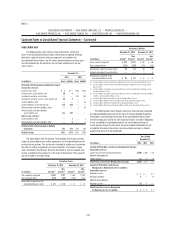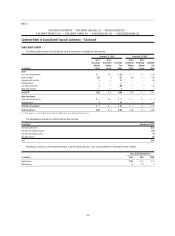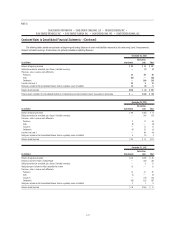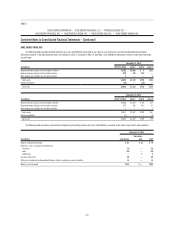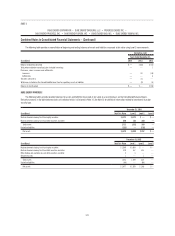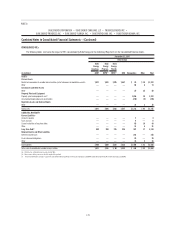Duke Energy 2014 Annual Report Download - page 189
Download and view the complete annual report
Please find page 189 of the 2014 Duke Energy annual report below. You can navigate through the pages in the report by either clicking on the pages listed below, or by using the keyword search tool below to find specific information within the annual report.
169
PART II
DUKE ENERGY CORPORATION • DUKE ENERGY CAROLINAS, LLC • PROGRESS ENERGY, INC. •
DUKE ENERGY PROGRESS, INC. • DUKE ENERGY FLORIDA, INC. • DUKE ENERGY OHIO, INC. • DUKE ENERGY INDIANA, INC.
Combined Notes to Consolidated Financial Statements – (Continued)
16. FAIR VALUE MEASUREMENTS
Fair value is the exchange price to sell an asset or transfer a liability in
an orderly transaction between market participants at the measurement date.
The fair value defi nition focuses on an exit price versus the acquisition cost.
Fair value measurements use market data or assumptions market participants
would use in pricing the asset or liability, including assumptions about risk and
the risks inherent in the inputs to the valuation technique. These inputs may
be readily observable, corroborated by market data, or generally unobservable.
Valuation techniques maximize the use of observable inputs and minimize use
of unobservable inputs. A midmarket pricing convention (the midpoint price
between bid and ask prices) is permitted for use as a practical expedient.
Fair value measurements are classifi ed in three levels based on the fair
value hierarchy:
Level 1 – Unadjusted quoted prices in active markets for identical assets or
liabilities that the reporting entity can access at the measurement date. An
active market is one in which transactions for an asset or liability occur with
suffi cient frequency and volume to provide ongoing pricing information.
Level 2 – A fair value measurement utilizing inputs other than quoted prices
included in Level 1 that are observable, either directly or indirectly, for an asset
or liability. Inputs include (i) quoted prices for similar assets or liabilities in
active markets, (ii) quoted prices for identical or similar assets or liabilities in
markets that are not active, (iii) and inputs other than quoted market prices that
are observable for the asset or liability, such as interest rate curves and yield
curves observable at commonly quoted intervals, volatilities and credit spreads.
A Level 2 measurement cannot have more than an insignifi cant portion of its
valuation based on unobservable inputs. Instruments in this category include
non-exchange-traded derivatives, such as over-the-counter forwards, swaps
and options; certain marketable debt securities; and fi nancial instruments
traded in less than active markets.
Level 3 – Any fair value measurement which includes unobservable inputs
for more than an insignifi cant portion of the valuation. These inputs may be
used with internally developed methodologies that result in management’s
best estimate of fair value. Level 3 measurements may include longer-term
instruments that extend into periods in which observable inputs are not
available.
The fair value accounting guidance permits entities to elect to measure
certain fi nancial instruments that are not required to be accounted for at fair
value, such as equity method investments or the company’s own debt, at fair
value. The Duke Energy Registrants have not elected to record any of these
items at fair value.
Transfers between levels represent assets or liabilities that were
previously (i) categorized at a higher level for which the inputs to the estimate
became less observable or (ii) classifi ed at a lower level for which the inputs
became more observable during the period. The Duke Energy Registrant’s policy
is to recognize transfers between levels of the fair value hierarchy at the end
of the period. There were no transfers between Levels 1 and 2 during the years
ended December 31, 2014, 2013 and 2012. Transfers out of Level 3 during
the year ended December 31, 2014 are the result of forward commodity prices
becoming observable due to the passage of time.
Valuation methods of the primary fair value measurements disclosed
below are as follows.
Investments in equity securities
The majority of investments in equity securities are valued using Level 1
measurements. Investments in equity securities are typically valued at the
closing price in the principal active market as of the last business day of the
quarter. Principal active markets for equity prices include published exchanges
such as NASDAQ and New York Stock Exchange (NYSE). Foreign equity prices
are translated from their trading currency using the currency exchange rate in
effect at the close of the principal active market. There was no after-hours market
activity that was required to be refl ected in the reported fair value measurements.
Investments in equity securities that are Level 2 or 3 are typically ownership
interests in commingled investment funds.
Investments in debt securities
Most investments in debt securities are valued using Level 2
measurements because the valuations use interest rate curves and credit
spreads applied to the terms of the debt instrument (maturity and coupon
interest rate) and consider the counterparty credit rating. If the market
for a particular fi xed income security is relatively inactive or illiquid, the
measurement is Level 3.
Commodity derivatives
Commodity derivatives with clearinghouses are classifi ed as Level 1.
Other commodity derivatives are primarily fair valued using internally developed
discounted cash fl ow models which incorporate forward price, adjustments for
liquidity (bid-ask spread) and credit or non-performance risk (after refl ecting
credit enhancements such as collateral), and are discounted to present value.
Pricing inputs are derived from published exchange transaction prices and
other observable data sources. In the absence of an active market, the last
available price may be used. If forward price curves are not observable for
the full term of the contract and the unobservable period had more than an
insignifi cant impact on the valuation, the commodity derivative is classifi ed as
Level 3. In isolation, increases (decreases) in natural gas forward prices result
in favorable (unfavorable) fair value adjustments for gas purchase contracts;
and increases (decreases) in electricity forward prices result in unfavorable
(favorable) fair value adjustments for electricity sales contracts. Duke Energy
regularly evaluates and validates pricing inputs used to estimate fair value of
gas commodity contracts by a market participant price verifi cation procedure.
This procedure provides a comparison of internal forward commodity curves to
market participant generated curves.
Interest rate derivatives
Most over-the-counter interest rate contract derivatives are valued using
fi nancial models which utilize observable inputs for similar instruments and
are classifi ed as Level 2. Inputs include forward interest rate curves, notional
amounts, interest rates and credit quality of the counterparties.
Goodwill and Long-Lived Assets and Assets Held for Sale
See Note 11 for a discussion of the valuation of goodwill and long-lived
assets and Note 2 related to the assets and related liabilities of the Disposal
Group classifi ed as held for sale.


